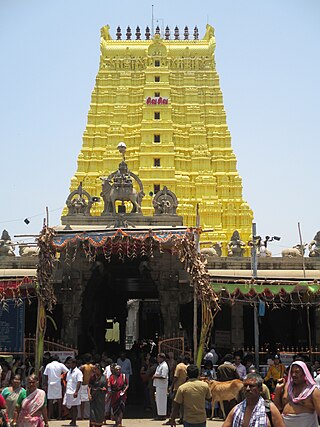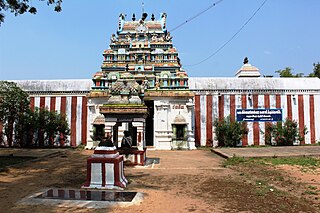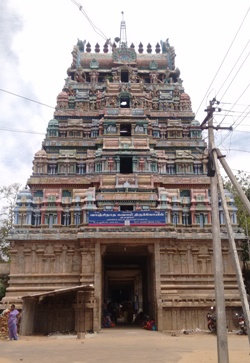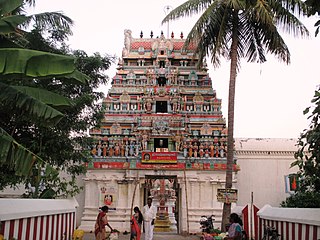
Mahamaham, also known as Mahamagham or Mamangam, is a Hindu festival celebrated every 12 years in the Mahamaham tank located in the city of Kumbakonam in Tamil Nadu in the south of India. This 20-acre square tank surrounded by Shiva mandapams is believed by Tamil Hindus to be ancient, and the holy confluence of nine Indian river goddesses: Ganga, Yamuna, Sarasvati, Narmada, Godavari, Krishna, Tungabhadra, Kaveri, and Sarayu, states Diana Eck – a professor of Comparative Religion and Indian Studies. On the day of the Mahamaham festival, the river goddesses and Shiva gather here to rejuvenate their waters, according to a legend in the Periya Purana. The Hindus consider taking a pilgrimage and holy dip at the Mahamaham tirtha on the day of Mahamaham festival as sacred. The event attracts chariot processions, street fairs and classical dance performances in temple mandapas. The 12-year cycle Mahamaham festival in Tamil Nadu is observed in the Hindu calendar month of Magha, and is a symbolic equivalent of the Kumbh Mela.
Tirtha is a Sanskrit word that means "crossing place, ford", and refers to any place, text or person that is holy. It particularly refers to pilgrimage sites and holy places in Hinduism, Buddhism and Jainism.

Parikrama or Pradakshina is clockwise circumambulation of sacred entities, and the path along which this is performed, as practiced in the Indic religions – Hinduism, Buddhism, Sikhism and Jainism. In Buddhism, it refers only to the path along which this is performed. Typically, in Indic-religions the parikrama is done after completion of traditional worship and after paying homage to the deity. Parikrama must be done with dhyāna.

Ramanathaswamy Temple is a Hindu temple dedicated to the Hindu god Shiva located on Rameswaram island in the state of Tamil Nadu, India. It is also one of the twelve Jyotirlinga temples. It is one of the 275 Paadal Petra Sthalams, where Nayanars, Appar, Sundarar and Tirugnana Sambandar, have glorified the temple with their songs. The Lingam of Ramanathaswamy (Shiva), was established and worshiped by Shri Rama, before he crossed his bridge to the present-day island of Sri Lanka. It is one of the Char Dham pilgrimage sites. The temple was expanded during the 12th century by the Pandya Dynasty, and its principal shrine’s sanctum was renovated by Jeyaveera Cinkaiariyan and his successor Gunaveera Cinkaiariyan, monarchs of the Jaffna kingdom. The temple has the longest corridor among all Hindu temples in India. It was built by King Muthuramalinga Sethupathiy. The temple, located in Rameswaram, is considered a holy pilgrimage site for Shaivites, Vaishnavites and Smarthas.

In Hinduism, the yatra (pilgrimage) to the tirthas has special significance for earning the punya needed to attain the moksha (salvation) by performing the darśana, the parikrama (circumambulation), the yajna, the Dhyana, the puja (worship), the prarthana, the dakshina, the seva, the bhandara, etc. These sacred places are usually located on the banks of sacred waters, such as sacred rivers or their tributaries, the kundas, the ghats, or the stepwells, or the temple tanks.

Yatra, in Indian-origin religions, Hinduism, Buddhism, Jainism and Sikhism, generally means a pilgrimage to holy places such as confluences of sacred rivers, sacred mountains, places associated with Hindu epics such as the Mahabharata and Ramayana, and other sacred pilgrimage sites. Visiting a sacred place is believed by the pilgrim to purify the self and bring one closer to the divine. The journey itself is as important as the destination, and the hardships of travel serve as an act of devotion in themselves.

The Char Dham, also rendered the Chatur Dhama is a set of four Hindu pilgrimage sites in India, consisting of Badrinath, Dwarka, Puri and Rameswaram. Badrinath, Dwarka, and Puri are shrines of Vishnu, whereas Rameswaram is a shrine of Shiva.

Vilwaneswarar temple is a Hindu temple dedicated to Shiva located in Thiruvaikavur, Tamil Nadu, India. The temple is located 8 km (5.0 mi) north of Kumbakonam, on the southern bank of Kollidam. Constructed in the Dravidian style of architecture, the temple is believed to have been built during the Cholas period in the 7th century. Shiva is worshipped as Vilwaneswarar and his consort Parvati as Valaikai Nayagi.

The Kānvar Yātrā is an annual pilgrimage of devotees of Shiva, known as Kānvarias (कावड़िया) or "Bhole" (भोले), to Hindu pilgrimage places of Haridwar, Gaumukh and Gangotri in Uttarakhand and Ajgaibinath, Sultanganj in Bhagalpur, Bihar to fetch holy waters of Ganges River. Millions of pilgrims fetch sacred water from river Ganga and carry on their shoulders for hundreds of miles to offer it in their local Śiva shrines, or specific temples such as Pura Mahadeva temple in Baghpat district and Augharnath temple in Meerut, Kashi Vishwanath temple in Varanasi, Baidyanath temple in Deoghar etc. In 2023, the Kanwar Yatra was held from 04-15 July.

Garbharakshambigai Temple is a Hindu temple dedicated to Shiva located in Thirukarukavoor, Tamil Nadu, India. The temple is located 6 km (3.7 mi) east of Papanasam, 20 km (12 mi) south east of Kumbakonam, 10 km (6.2 mi) north of Saliyamangalam, 20 km (12 mi) north east of Thanjavur and on the southern bank of Vettar River. Nearest railway station is Papanasam Railway Station, which is 5 kms away from Thirukarukavoor. Constructed in the Dravidian style of architecture, the temple is believed to have been built during the Cholas period in the 7th century. Shiva is worshipped as Mullaivananathar and his consort Parvathi as Garbharakshambigai.

Vanchinadha Swamy temple is a Hindu temple dedicated to the deity Shiva, located in Srivanchiyam, Tiruvarur District, Tamil Nadu, India. Shiva is worshiped as Vanchinadha Swamy, and is represented by the lingam. His consort Parvati is depicted as Mangalambigai Amman. The presiding deity is revered in the 7th century Tamil Saiva canonical work, the Tevaram, written by Tamil saint poets known as the Nayanmars and classified as Paadal Petra Sthalam.

Prananadeswarar Temple is a Hindu temple dedicated to Shiva located in Thirumangalakudi in Mayiladuthurai district of Tamil Nadu, India. Shiva is worshiped as Prananatheswarar, and is represented by the lingam and his consort Parvati is depicted as Mangala Nayagi. The presiding deity is revered in the 7th century Tamil Saiva canonical work, the Tevaram, written by Tamil poet saints known as the nayanars and classified as Paadal Petra Sthalam.

Mahamaham tank is a huge temple tank located in Kumbakonam, Tamil Nadu, India. It is considered to be the foremost and one of the largest temple tanks in Tamil Nadu. The Masimaham festival held in the tank has 100,000 visitors and the once-in-12-year Mahamaham festival has close to 2 million visitors.

The Gajendra Varadha Perumal Temple in Thirukkavithalam, a village in the outskirts of Papanasam in the South Indian state of Tamil Nadu, is dedicated to the Hindu god Vishnu. Constructed in the Dravidian style of architecture, the temple is glorified in the Nalayira Divya Prabandham, the early medieval Tamil canon of the Alvar saints from the 6th–9th centuries CE. It is one of the 108 Divya Desams dedicated to Vishnu, who is worshipped as Gajendra Varadha Perumal and his consort Lakshmi as Ramamanivalli. The temple is one of the five Pancha-Kannan temples, where Krishna, an avatar of Vishnu is given prominence over the presiding deity.

The Thiru Aadanoor or the Andalakkum Aiyan Perumal Temple is a Hindu temple dedicated to Vishnu located in Aadanoor, Thanjavur district in Tamil Nadu, India. Constructed in Dravidian style of architecture, the temple is glorified in the Nalayira Divya Prabandham, the early medieval Tamil canon of the Alvar saints from the 6th–9th centuries CE. It is counted as one among the 108 Divya Desams dedicated to Vishnu. Vishnu is worshipped as Andalakkum Aiyan and his consort is worshipped as Ranganayaki, a form of Lakshmi.

Nathan Kovil or Thiru Nandipura Vinnagaram Temple in Nathan Kovil, a village in the outskirts of Kumbakonam in the South Indian state of Tamil Nadu, is dedicated to the Hindu god Vishnu. Constructed in the Dravidian style of architecture, the temple is glorified in the Nalayira Divya Prabandham, the early medieval Tamil canon of the Alvar saints from the 6th–9th centuries CE. It is one of the 108 Divya Desams dedicated to Vishnu, who is worshipped as Jagannathan and his consort Lakshmi as Shenbagavalli.

Mahamaham Stampede was a disaster that occurred during the Mahamaham festival on 18 February 1992 around the Mahamaham tank located in the town of Kumbakonam in the South Indian state of Tamil Nadu. An estimated 50 people were killed in the stampede that left another 74 injured. The festival was attended by the then Chief Minister of Tamil Nadu, Jayalalitha, who had a holy dip in the tank.

Theerthamalai is an important sacred place in Harur taluk of Dharmapuri district, located in Tamil Nadu, India. The name Theerthamalai in Tamil means Hill with Holy Water. Theerthamalai is a village situated about 16 km northeast of Harur. Theerthagirishwarar Temple is located at the top of a hillock. The temple, situated about 1 km up the steep slope of the hillock, derives its name from the five springs in the temple. Lord Theerthagireeswar (Shiva) is the worshipping deity.

2016 Mahamaham is a recurring festival most recently celebrated at Kumbakonam in Thanjavur district of Tamil Nadu, India from 13 February 2016 to 22 February 2016. Mahamaham, also known as Mahamagham or Mamangam, is a Hindu festival celebrated every 12 years in the Mahamaham tank in Kumbakonam.




















